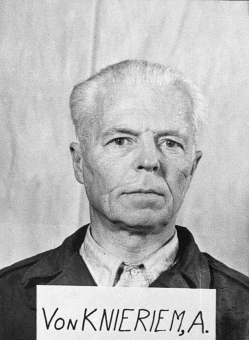August von Knieriem (1887–1978)

© National Archives, Washington, DC
“Dr. von Knieriem was not the Chief of the legal department of the I.G., because such a department did not exist. It was also not his duty to take care of legal matters. The judicial activity in such an enterprise is that of an auxiliary function, assisting the technicians and businessmen in their tasks and was like the latter heavily decentralized.”[1]
August von Knieriem was born in Riga on June 11, 1887. His father, a judge in the higher regional court, was Oberlandesgerichtsrat Dr. jur. Johann August von Knieriem, and his mother was Maria (née Schwartz). After attending school in Hamburg and Lübeck, August von Knieriem studied law in Tübingen and Berlin, graduating in 1908 after passing the first state law exam and obtaining a doctoral degree in law. In 1913, he was working as a trained lawyer (with the second state law exam) in Hamburg and for Lloyds in London, and one year later he became a partner in a Hamburg law firm. In 1914, he fought in World War I and was wounded, and in 1915 he became an economic advisor in the Raw Material Department of the War Ministry.
In 1919, August von Knieriem did freelance legal work at BASF in the so-called Nitrogen Syndicate (Stickstoffsyndikat); three years later he joined BASF’s legal department. He was promoted quickly at BASF, becoming an alternate board member and head of the legal department in 1923. Owing to his specialization in the field of patent and cartel law, he was part of the team working on the contracts for the I.G. Farben conglomerate in 1924 and 1925. With the establishment of I.G. Farben, von Knieriem first was made an alternate member of the managing board, and from 1932 until 1945 he served as a full member of the board. When the military situation shifted to the disadvantage of Germany, the “head of the I.G.’s legal department” took the precaution of working out the initial decartelization proposals for the enterprise in summer 1944, as it was probable “that we would be forced into a splitting up of our enterprise.”[2]
In 1937, he assumed the chairmanship of I.G. Farben’s Legal Committee, and in 1938 he became a member of the managing board’s Central Committee. On the board, von Knieriem was responsible for legal contractual matters in the negotiations with the Wehrmacht regarding the setup of secret plants for making chemical weapons. Von Knieriem married Gertrud Bueb, and the couple had three sons. He joined the NSDAP in 1942. In 1945, August von Knieriem was arrested by the U.S. military administration, and in 1947 he was a defendant in the I.G. Farben Trial at Nuremberg, charged with plundering and enslavement. He was acquitted, as the judges could prove no criminal responsibility in these matters on his part
(SP; transl. KL)
















